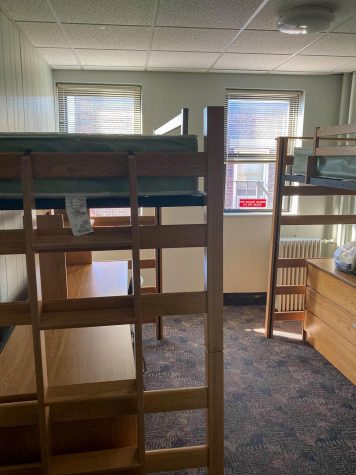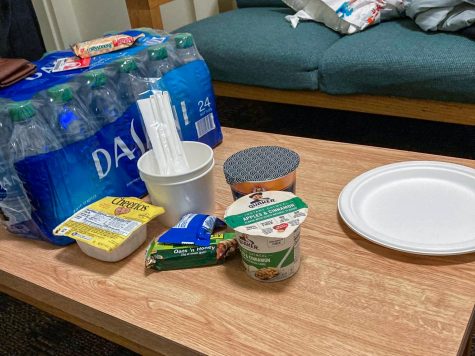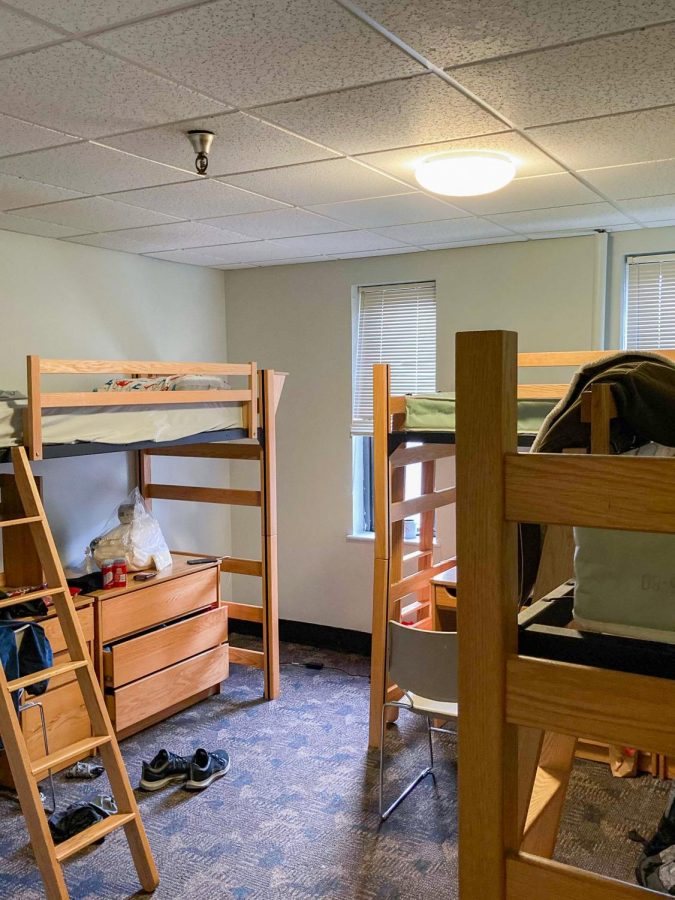Quarantine affects students’ mental health
Many Northeastern students in wellness housing experience mental health challenges such as heightened stress levels.
March 4, 2021
When a student at Northeastern tests positive for COVID-19, their close contacts must remain in isolation housing for eight days after their initial exposure. Some individuals stay longer, however, and this social isolation has led to new mental health challenges for quarantined students.
Students’ time in wellness housing can range anywhere from eight days to 18. If a student tests positive, they must quarantine for 10 days even if they were already in wellness housing.
For some students, days in quarantine can feel like a lifetime. Since they’re prohibited from visiting anyone, their only human interaction is with test administrators at the Huntington Testing Center, a separate testing facility for both those showing symptoms and students who have been directly exposed to COVID-19.
The removal of face-to-face communication is unnatural for humans, and can even result in changes in the brain, according to Northeastern professor of psychology Kyle Gobrogge.
“Socializing is a natural reward and, when you remove it from a social species — like humans — it can cause a whole host of organic issues in the brain,” Gobrogge said. “Dopamine [and] oxytocin [are] neuropeptides that will change the way in which [the brain] communicates and helps neurons facilitate synaptic transmission.”
Jack Hansen, a first-year mechanical engineering student, spent eight of his first 13 days on campus in International Village’s wellness housing. He said he experienced adverse mental health effects.
“It definitely was not an easy adjustment,” Hansen said. “It felt like I was trapped in there for weeks.”
Hansen, a self-proclaimed extrovert, spent his first semester of college in Dublin last fall, as a part of the N.U.in program.
“I hardly had time to get settled in before I was moved out,” Hansen said. “I met two new people, but that was it…So I didn’t get a chance to connect with many students on campus before classes started.”
It wasn’t just the inability to make new acquaintances that bothered him, Hansen said it was difficult to communicate with close friends and family.
“It was just hard only talking to them virtually. I need that face-to-face interaction,” Hansen said. “Talking to people definitely made it easier, but I still couldn’t wait to get out of that place. Calling them or FaceTiming made me want to be with my friends even more.”

Gobrogge noted that feeling unfulfilled by virtual communication is normal.
“You can get similar levels of dopamine or oxytocin through two-dimensional audio or visual socializing, but it is not as robust as being face-to-face with somebody or socializing in that way,” Gobrogge said.
Aside from the isolation from friendly faces, other aspects of the isolation process began to get to Hansen. Struggling with the scant vegetarian options, Hansen said the food hampered his ability to manage isolation.
“To be perfectly honest, their vegetarian options were garbage,” he said. “I don’t know if I can eat lentils ever again. They provided plenty of food — it just came to a point where I couldn’t stomach it anymore. That consistent diet, combined with some isolation hysteria, led me to throwing food at the wall several times in those final days.”
Hansen may not have known it then, but there may have been a concrete scientific reason for his “isolation hysteria”.
Gobrogge identified the lack of social interaction as the top stress producer in cases like Hansen’s.
“The social buffering of stress is the x-factor here,” Gobrogge said. “The underlying x-factor is, without socializing in person we are missing this stress-buffering that is important for humans to function in a healthy emotionally stable society.”
As the days wound down, Hansen said he did everything he could to leave quarantine housing. He began to receive tests on consecutive days to prove his health, and also spent hours on the phone with Northeastern staff.
Tom Eckel, Hansen’s roommate, was designated a close contact the same day as Hansen. Eckel, a first-year engineering student, was sent to quarantine housing and said he experienced similar paranoia as a result of prolonged isolation.
“The isolation did not help my mind initially. I couldn’t get the image out of my head, that, as soon as I opened the bathroom door, the adjoining room’s door would click shut as if someone else was there,” Eckel said. He described his life in isolation as “monotonous” and “lonely.”
While initially, the eight-day stay was a difficult one, Eckel eventually adjusted to life alone. Eckel stayed in touch with people close to him and developed new hobbies in isolation.

“I called my family and girlfriend a lot to pass the time, and I completed a pretty extensive embroidery project,” he said.
Dylan Hruskar, a first-year student in the Explore Program, entered wellness housing on Feb. 22, right at the height of his midterms. He said he particularly struggled while taking certain exams.
“I had to read questions over again, I was getting very frustrated with myself, at the end of an exam I got rather upset. I took my drawer and started slamming it, I had a little bit of a mental breakdown after the exam,” Hruskar said. “My professor was very understanding and said I could wait until the next day to take it, but I just wanted to get it over with and off my mind.”
Outside of just the exam schedule, Hruskar found it difficult to stay focused in class after previously experiencing in-person classes.
“It is a lot harder to pay attention and engage in virtual class,” Hruskar said. “When you are in class and talking to people you pay attention a lot more, so I have certainly been struggling to pay attention in classes, especially when I have a lot in a row.”
Hruskar said he is thankful to be able to still have a good support system while he grinds through virtual school and exams, and appreciates the accommodations Northeastern provides.
“I think having people to talk to helps a lot, it is great to have the support of friends and family,” he said. “Of course Northeastern is emailing me every day offering mental health support if I need it, so overall I don’t feel quite as alone as I thought I would.”
College students like Hansen, Hruskar and Eckel, are particularly vulnerable to the effects of social isolation, as their brain is still developing throughout a person’s early 20s, due to a process called myelination.
“What is dramatically different even between a college-age brain and my brain which is at almost 40 is the frontal lobe,” Gobbroge said. “Even though the dopamine levels are similar, the myelination of areas like the frontal lobe that are involved with decision making, top-down control of impulses, emotional stability and that kind of regulation is very different in the college-age brain.”
Among students at Northeastern, Jack Hansen and Tom Eckel are not alone in their quarantine experiences. As of (date of publication), there are 76 students in on-campus wellness housing and 132 students in off-campus quarantine housing.

“When you don’t have those face-to-face social experiences, somebody who is more vulnerable to stress is exacerbated. As the absence of social contact physically with people gets longer and longer, the stress-buffering effect goes away,” Gobrogge said. “The longer somebody is socially isolated, the worse the product can be later on.”
Sustained social isolation can have adverse effects on one’s mind, and it is necessary to understand the importance of mental health during these times. A lack of face-to-face interaction leaves humans more vulnerable to stress and mental health challenges down the road, especially if they had a past history of mental health issues.
“Say if you and I were best friends and we were separated for a year or longer. Our stress vulnerability is much higher,” Gobrogge said. “Because stress intersects [with] depression and anxiety, [it] is a trigger for drug and alcohol abuse, [it] can trigger neurodegenerative diseases like Alzheimer’s in old age, depression in young age, suicidality, schizophrenia. When you remove a natural reward like socializing in a species that is highly social, it can create all these negative affective side effects.”






